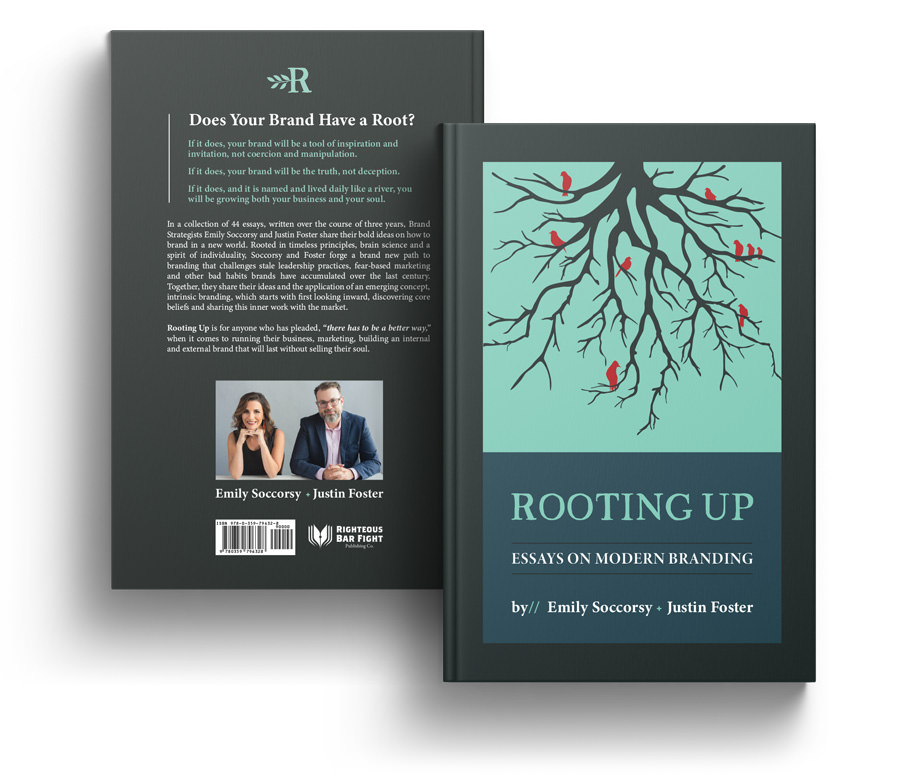Filed Under: Intrinsic Branding, Leadership
By Emily Soccorsy
What do you intend?
As a human? As an individual facing a set of circumstances? Are you accustomed, at all, to reflecting on your intentions?
I’ll posit most of us are not.
What we tend to fix our gaze squarely upon instead is what we want, what we desire, the outcome we envision. We look at outcomes as a great resolver of current issues, as a powerful panacea for what ails us now. As we see an outcome, we imagine it will fix our flaws.
It’s unrealistic. And this outcome-obsessed outlook sets us up not just for disappointment, but also for dissatisfaction as we lose our ability to appreciate what comes our way as we journey along, as we discover, as we reveal more pressing or relevant truths and alter our courses.

We also over-inflate the importance of outcomes as we sell things.
I’ve spent 25 years of my career in strategic communication. From those experiences, I can confidently say we spend far too much of our mental energy on outcomes than we do on the process. Outcomes are momentary, high-stakes and risky. Process is ongoing, fruitful, collaborative, and often very distinctive.
Process without outcomes can be wasted time, it’s true. But process very often gives way to new ways of thinking, new outcomes, curiosities or opportunities perhaps more valuable than the initial imagined outcome. Take the invention of Post-It Notes, for example, or penicillin, safety glass, the Pacemaker, Teflon, the microwave oven, velcro, matches – and two particularly yummy oopsies, potato chips and beer.
One of the most overused (and for me loathed) words in the world of business and marketing is “solutions.” I flat out refuse to use the word “solution” or “solution provider” in any of my branding work. It’s come to mean absolutely nothing. It’s linguistically lazy, and in most cases, it is overpromising.
We overuse and overvalue the shortcut “solutions” because we know, as fellow humans, that in our pain that’s what the reptilian brain wants. We want some once-and-for-all widget to stop the inefficiency, pain, cancer, lack of sales, lack of marketing, lack of visibility, lack of whatever. There’s nothing wrong with imagining success, but in our culture, particularly in business, we are blindly obsessed with it.
We promise “once and for all solutions,” “surefire solutions,” “10x solutions.”
In my decade as an entrepreneur, I have found that true solutions are rare.
More than that: it is dangerous to think of any one thing as a solution!
Yes, I’ve found strategies that help me, that reduce burn or inefficiency and increase communication. I’ve bought and run programs and apps and services and operating protocols that have helped support me in part of my business I am not as strong in.
But every so-called “solution” requires time, investment and care. Most solutions are not “set-it-and-forget it” finite. They are not turnkey. Once implemented, they require us to see around the next corner and adapt for this or that and recalibrate.
I think that’s why I do puzzles every morning over my morning cup of coffee. It feels so satisfying to solve the Wordle in less than five tries or conquer the Mini in just a few minutes.
Puzzles have solutions.
Life – and work – do not.
They are ongoing processes of discovery, support and reimagining, pivoting, rethinking and iterating.
Which brings me back to the value of intention.
Stay Fixed on Intention
Both in life and work, I encourage all of us to stay fixed on intention. What do we want? What is our heart saying? How can we build a company based on core values (we call them beliefs and standards at Root + River) that reflect our deepest intentions? I know when I stray from or lose track of my intentions, I feel drained, overwhelmed and unsure. When I refocus on our beliefs and standards (LINK), I am centered, grounded and energized.
Honor Process
I also encourage us to honor process. I encourage us to look for partners, collaborations, methods and approaches that make sense to us, that challenge us to think in new ways. I encourage us to give process time and space to work. I often get frustrated by process and I feel urgency to hurry up for the outcome or big win. While sometimes that urgency can be very helpful in securing accomplishments and finishing projects, it can sometimes lead to cutting corners, undermining the process and, at times, lackluster results.
Check Your Need for Solutions
And I encourage us to check our own desire for mythical “solutions.” When my mom was fighting pancreatic cancer, I used to watch this SNL skit featuring Keenan Thompson over and over. When asked what needed to be done to address the financial crisis, Thompson’s character, repeatedly said, “Identify the problem then FIX IT!” That’s how I felt about the situation we were facing. I just wanted it to be fixed. I wanted the chemotherapy, radiation and surgeries to fix the cancer. I was hunting down a solution to the problem of cancer.
There wasn’t a solution there. But within the process, there was love, support, nurturing, appreciation, and eventually an outcome we had to learn how to bear. Such are the rolling hills of life.
At the root of intention are excellent questions. Here are a few I use to help me get clear on my intention. They’re my gift to you for reading this long!
What questions do you ask yourself to center yourself and uncover what you truly want or need?
Outcome-Focused Questions
Do we intend to produce? What do we intend to produce?
Do we intend to resolve? What do we intend to resolve?
Do we intend to solve? What do we intend to solve?
Do we intend to generate outcomes? What outcomes do we intend to generate?
Process-Focused Questions
Do we intend to create? What do we intend to create?
Do we intend to discover? What do we intend to discover?
Do we intend to wonder? What do we intend to wonder?
Do we intend to be curious? What do we want to be curious about?
Do we intend to find joy? What joy resides right here?
Lastly, a challenge.
As your brand strategist, I’m asking that you please consider removing “solution” from your brand language. What else might you say? How would you describe your process? Your support? The benefits of your system? Explore the language that might better illustrate those aspects of the brand for your audience. You may find it freeing. It will help you sound differently.
And your audience will likely feel your intention in every word.
